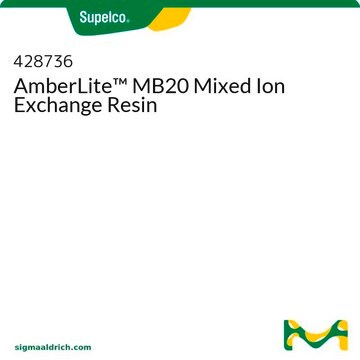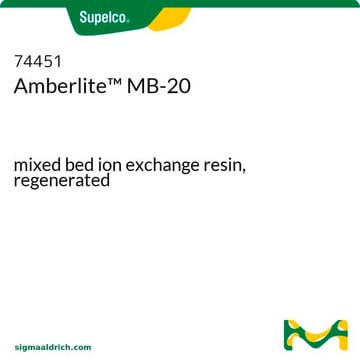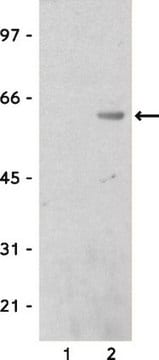M8032
Mixed Bed Resin
BioReagent, for molecular biology
Synonym(s):
Mixed Bed Resin hydrogen and hydroxide form
Sign Into View Organizational & Contract Pricing
All Photos(2)
About This Item
Recommended Products
grade
DNA grade
for molecular biology
product line
BioReagent
form
beads
pH
<5
foreign activity
DNase, RNase, none detected
storage temp.
room temp
Looking for similar products? Visit Product Comparison Guide
General description
A self-indicating Mixed Bed Resin for deionizing formamide, acrylamide, glyoxal, PEG and urea. The beads change color from blue to gold when exchange capacity is reached. Also, the color indicator turns gold with formamide immediately, so deionization must be checked by measuring conductivity.
Application
Mixed Bed Resin is suitable for deionizing formamide, acrylamide, glyoxal, PEG and urea, on a column or in a batch process.
related product
Product No.
Description
Pricing
Signal Word
Danger
Hazard Statements
Precautionary Statements
Hazard Classifications
Eye Dam. 1
Storage Class Code
11 - Combustible Solids
WGK
WGK 3
Flash Point(F)
Not applicable
Flash Point(C)
Not applicable
Personal Protective Equipment
dust mask type N95 (US), Eyeshields, Gloves
Certificates of Analysis (COA)
Search for Certificates of Analysis (COA) by entering the products Lot/Batch Number. Lot and Batch Numbers can be found on a product’s label following the words ‘Lot’ or ‘Batch’.
Already Own This Product?
Find documentation for the products that you have recently purchased in the Document Library.
A I Alayash
Free radical biology & medicine, 18(2), 295-301 (1995-02-01)
Chemical modifications of human or bovine hemoglobins are designed to produce proteins that can act as oxygen-carrying blood substitutes. Concerns about the redox reactivity of cell-free hemoglobin and its contribution to tissue-damaging oxygen free radicals has not been fully established.
Chih-Hsiu Lin et al.
Langmuir : the ACS journal of surfaces and colloids, 29(25), 7793-7801 (2013-05-25)
Zeta potentials of several polar protic (water, ethylene glycol, and formamide) as well as polar aprotic (dimethyl sulfoxide) liquids were measured in contact with three nonpolar surfaces using closed-cell electroosmosis. The test surfaces were chemisorbed monolayers of alkyl siloxanes, fluoroalkyl
E G Vilela et al.
Brazilian journal of medical and biological research = Revista brasileira de pesquisas medicas e biologicas, 41(12), 1105-1109 (2009-01-17)
The gut barrier monitors and protects the gastrointestinal tract from challenges such as microorganisms, toxins and proteins that could act as antigens. There is evidence that gut barrier dysfunction may act as a primary disease mechanism in intestinal disorders. The
Sambrook, J., et al.
Molecular Cloning: A Laboratory Manual, 1-1 (1989)
Glycogen synthase activity in adipose tissue. Methods for freeze-clamping and assay.
H K Ortmeyer
Methods in molecular biology (Clifton, N.J.), 155, 89-96 (2001-04-11)
Our team of scientists has experience in all areas of research including Life Science, Material Science, Chemical Synthesis, Chromatography, Analytical and many others.
Contact Technical Service








